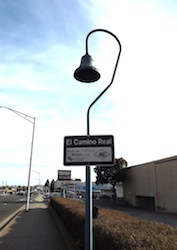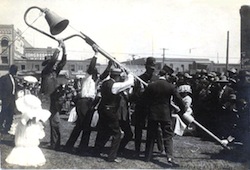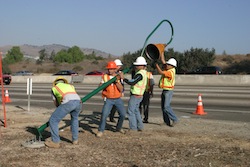Mission Bell Marker Project
 Driving along El Camino Real people have noticed more Mission Bells posted along the familiar thoroughfare. That is because this past fall of 2012, the El Camino Mission Bell Marker Project was completed, thanks to the dedicated efforts of Chris Rossmiller, landscape architect and project manager for a portion of the statewide Project and Keith Robinson, Principal Landscape Architect for Caltrans.
Two federal Transportation Enhancement grants totaling nearly $2 million were received by Caltrans in 2000 and 2010 to fund the restoration of the Mission Bell Marker system on the legislatively designated El Camino Real from Orange County to Sonoma.
Funding was received for the making and installation of approximately 585 Mission Bell Markers, placed approximately one to two miles apart along the roadside in the northbound and southbound directions on California State Routes 101, 82, 37, 121, and 12. This includes the Bay Area – Caltrans District 4 (Oakland), the Central Coast – Caltrans District 5 (San Luis Obispo), and the Southland – Caltrans District 7 (Los Angeles).
When this reporter called Rossmiller he noted that he and Robinson have received lots of calls. “The response has been positive,” he said. “People are pleased to see the Mission Bells and it has stirred an interest in California history.”
Rossmiller credited Robinson as the driving force behind the project.
Driving along El Camino Real people have noticed more Mission Bells posted along the familiar thoroughfare. That is because this past fall of 2012, the El Camino Mission Bell Marker Project was completed, thanks to the dedicated efforts of Chris Rossmiller, landscape architect and project manager for a portion of the statewide Project and Keith Robinson, Principal Landscape Architect for Caltrans.
Two federal Transportation Enhancement grants totaling nearly $2 million were received by Caltrans in 2000 and 2010 to fund the restoration of the Mission Bell Marker system on the legislatively designated El Camino Real from Orange County to Sonoma.
Funding was received for the making and installation of approximately 585 Mission Bell Markers, placed approximately one to two miles apart along the roadside in the northbound and southbound directions on California State Routes 101, 82, 37, 121, and 12. This includes the Bay Area – Caltrans District 4 (Oakland), the Central Coast – Caltrans District 5 (San Luis Obispo), and the Southland – Caltrans District 7 (Los Angeles).
When this reporter called Rossmiller he noted that he and Robinson have received lots of calls. “The response has been positive,” he said. “People are pleased to see the Mission Bells and it has stirred an interest in California history.”
Rossmiller credited Robinson as the driving force behind the project.
“We wanted to keep the same intent and maintain the initial historical integrity of the Mission Bell system,” he said. Rossmiller also noted that, “the bells we used for the project are actually made from the same molds as the originals.”
 The Mission Bell Marker system has existed on the historic route of the El Camino Real since 1906. The original marker system intended installation of bells one mile apart along the entire length of the El Camino Real from San Diego to Sonoma. By 1913 over 450 markers were placed on El Camino Real, but by the 1950s fewer than 70 survived.
Setting a goal of using an replica of the original bells was a challenge – needed to find a foundry willing to recast a mold from one of the original bells Caltrans had in its HQ library. But due to some early media attention the actual original bell molds were located and used for manufacture of the new bells. That is definitely a project highlight, the bells are the same as those on the El Camino real over a hundred years ago. Fortunately for Rossmiller, Robinson and the workers on the project, the company that made the original set of bells back in 1906 is still in business. “I bought the California Bell Company in 2000,” said owner John Kolstad.
How he came to be the current proprietor of this 100 year old company is a story within itself. As Kolstad explained, “I am a loan and real estate man by profession, yet when I wanted a mission bell for my backyard, I was referred to the California Bell Company and Joe Rice was then the owner.”
Rice offered to sell the company to Kolstad. Yet as Kolstad recalled, “the price was too high and I started to negotiate with him.” “I said, Joe if you don’t sell this to me, then most likely your century-old business will disappear and along with it all the metal craft of bell making and lots of history will be lost.”
Rice agreed and so Kolstad bought the company. Kolstad a native of Southern California had an interest in California history. He was eager to learn the craft and business of bell making, often taking trips to old missions beyond El Camino Real, further along the South West, like Arizona. Kolstad even made trips to the Missions established by Father Junipero Serra in Mexico before the Franciscan “Padres” established Missions in California.
Fortunately for Kolstad in his search for interested patrons in his acquired business he met Robinson. Contacting Robinson who works for Caltrans, he explained, “I recalled seeing the bells when I was 5 or 6 years old; when my family would visit my grandmother who lived in San Francisco.”
Robinson surmised, “the bell markers and the story of the Mission fathers made an impression on me.” As I grew up and saw the tremendous changes and expansion in the state, he said, it seemed a real loss that the few bells I recalled on Rte 82 were disappearing.”
Robinson noted, “my position at Caltrans gave me access to the special grant programs available for transportation enhancements,” and he considers that very fortunate. Because as he explained, “I wanted to see if the history of the El Camino Real could be rekindled in the people’s mind so that the image of the El Camino Real would be about the first road in California and not an over developed haphazard commercial strip or an unremarkable freeway.”
Both he and Kolstad mentioned that all the work done to restore the bell markers could only be done on State Highways and routes. “Those parts of El Camino Real that meander onto City and Town roadways could not be included because they are not a part of the State highway system,” noted Robinson.
The Mission Bell Marker system has existed on the historic route of the El Camino Real since 1906. The original marker system intended installation of bells one mile apart along the entire length of the El Camino Real from San Diego to Sonoma. By 1913 over 450 markers were placed on El Camino Real, but by the 1950s fewer than 70 survived.
Setting a goal of using an replica of the original bells was a challenge – needed to find a foundry willing to recast a mold from one of the original bells Caltrans had in its HQ library. But due to some early media attention the actual original bell molds were located and used for manufacture of the new bells. That is definitely a project highlight, the bells are the same as those on the El Camino real over a hundred years ago. Fortunately for Rossmiller, Robinson and the workers on the project, the company that made the original set of bells back in 1906 is still in business. “I bought the California Bell Company in 2000,” said owner John Kolstad.
How he came to be the current proprietor of this 100 year old company is a story within itself. As Kolstad explained, “I am a loan and real estate man by profession, yet when I wanted a mission bell for my backyard, I was referred to the California Bell Company and Joe Rice was then the owner.”
Rice offered to sell the company to Kolstad. Yet as Kolstad recalled, “the price was too high and I started to negotiate with him.” “I said, Joe if you don’t sell this to me, then most likely your century-old business will disappear and along with it all the metal craft of bell making and lots of history will be lost.”
Rice agreed and so Kolstad bought the company. Kolstad a native of Southern California had an interest in California history. He was eager to learn the craft and business of bell making, often taking trips to old missions beyond El Camino Real, further along the South West, like Arizona. Kolstad even made trips to the Missions established by Father Junipero Serra in Mexico before the Franciscan “Padres” established Missions in California.
Fortunately for Kolstad in his search for interested patrons in his acquired business he met Robinson. Contacting Robinson who works for Caltrans, he explained, “I recalled seeing the bells when I was 5 or 6 years old; when my family would visit my grandmother who lived in San Francisco.”
Robinson surmised, “the bell markers and the story of the Mission fathers made an impression on me.” As I grew up and saw the tremendous changes and expansion in the state, he said, it seemed a real loss that the few bells I recalled on Rte 82 were disappearing.”
Robinson noted, “my position at Caltrans gave me access to the special grant programs available for transportation enhancements,” and he considers that very fortunate. Because as he explained, “I wanted to see if the history of the El Camino Real could be rekindled in the people’s mind so that the image of the El Camino Real would be about the first road in California and not an over developed haphazard commercial strip or an unremarkable freeway.”
Both he and Kolstad mentioned that all the work done to restore the bell markers could only be done on State Highways and routes. “Those parts of El Camino Real that meander onto City and Town roadways could not be included because they are not a part of the State highway system,” noted Robinson.
 “Getting towns and local city planners to help is not easy, some are just not interested and usually it is about budgets and the formality of council meetings, hearings and committees,” said Kolstad.
With a clear focus set forth, Robinson put together the grant proposal in about six months. “Much of that time was navigating the process and gathering background information,” he said.
The original grant funded 555 bells from San Francisco to Orange County – “including installation of the staff and sign,” said Robinson. “This was approximately the number of bells that would have been placed if the original vision from 1906 had been realized,” said Robinson. He admitted some of the work took longer than anticipated. Issues of safety and engineering had to be taken into account. And, locating an original bell mold, while a highlight of the project it still required some effort. Undaunted, Robinson was determined.
”During the research, said Robinson, I learned first hand just how important civic groups, especially women’s clubs have been in preserving California history and in protecting transportation features and still are.”
”Lots of great documents on the statewide effort by women’s clubs in the early 1900s to preserve the missions, and memorialize the El Camino Real are archived.” “The various clubs and groups worked hard to have the El Camino Real preserved and took on the task of creating and funding and installing a bell marker system.” “So, even then, the states history wouldn’t be lost,” said Robinson.
”The bells are back,” exclaimed Robinson. “The traveler is reminded of a California before malls, traffic, and blight. Just under the pavement is real California history many were unaware of,” he said. “El Camino Real is ‘The first highway’ in the state,” he said.
“Getting towns and local city planners to help is not easy, some are just not interested and usually it is about budgets and the formality of council meetings, hearings and committees,” said Kolstad.
With a clear focus set forth, Robinson put together the grant proposal in about six months. “Much of that time was navigating the process and gathering background information,” he said.
The original grant funded 555 bells from San Francisco to Orange County – “including installation of the staff and sign,” said Robinson. “This was approximately the number of bells that would have been placed if the original vision from 1906 had been realized,” said Robinson. He admitted some of the work took longer than anticipated. Issues of safety and engineering had to be taken into account. And, locating an original bell mold, while a highlight of the project it still required some effort. Undaunted, Robinson was determined.
”During the research, said Robinson, I learned first hand just how important civic groups, especially women’s clubs have been in preserving California history and in protecting transportation features and still are.”
”Lots of great documents on the statewide effort by women’s clubs in the early 1900s to preserve the missions, and memorialize the El Camino Real are archived.” “The various clubs and groups worked hard to have the El Camino Real preserved and took on the task of creating and funding and installing a bell marker system.” “So, even then, the states history wouldn’t be lost,” said Robinson.
”The bells are back,” exclaimed Robinson. “The traveler is reminded of a California before malls, traffic, and blight. Just under the pavement is real California history many were unaware of,” he said. “El Camino Real is ‘The first highway’ in the state,” he said.
Leave a Reply